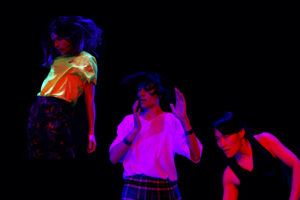Clara Furey’s Dog Rising: Grooving to the sound of celestial collisions - Vancouver Ballet Society
- Home
- Reviews 2020 - 2023
- Clara Furey’s Dog Rising: Grooving to the sound of celestial collisions

By Didier Morelli
On March 17, the first warm spring evening of 2022 in downtown Ottawa, early evening club-goers strut down the streets in minimal clothing and the air is thick with the humidity of melting snow. Inside the glassy postmodern building that houses La Nouvelle Scène, Le Théâtre du Trillium presents Montreal choreographer Clara Furey’s latest project, Dog Rising. For just over one hour, we are treated to the prowess of three dancers in constant action and reaction to each other as they groove to the sound of celestial bodies colliding in the ether.
Furey didn’t start out in dance: she was musically trained at the Conservatoire de Paris before beginning a career as a singer-songwriter. A successful performer with early-career exploits in music, film, and theatre, she then graduated from the École de danse contemporaine de Montréal in 2003. Cosmic Love (2017), which established Furey’s gift for creating intimate, minimalist, kinetic landscapes, was her first solo work in association with Parbleux, a centre of contemporary creation in Montreal.

Dog Rising, which according to program notes alludes to a polyphony of pulsating bodies, continues in this creative vein. The liveliness of playful costumes, the bare stage paired with dynamic lighting design by Karine Gauthier, and the suspense of an expertly crafted electro-acoustic musical score by long-time collaborator (and brother) Tomas Furey, all produce prime conditions for the dancers to stand motionless and still enthral.
At the start, three performers dressed in monochrome primary colours unceremoniously walk through the auditorium to take their positions across the stage from each other. Be Heintzman Hope, Baco Lepage-Acosta, and Brian Mendez are undeniably cool in loose-fitting, bright, androgynous clothing, a blend of recent fashion fads of normcore and athleisure. The trio looks poised to walk off the street into a coffee shop, a gym, a rave, or even a museum. And then the dancing begins.
As Lepage-Acosta, dressed in red, and Mendez, in yellow, look on, Heintzman Hope, in blue, initiates a back and forth, hip-rocking motion. This teeters on the type of behaviour you might notice at a party when someone grooves vaguely to a familiar song. Only this action, in which the dancer transfers all of their bodily weight with each step, carries with it a clear intention and concentration. Heintzman Hope repeats this small, simple sequence almost forcefully, as if it were a task. Paired with a soundtrack that could be described as two electrodes whooshing past each other repeatedly in an incessant and driving rhythm, the effect is hypnotic.

Lepage-Acosta and Mendez join in with their own signature moves. Each isolates different parts of their bodies with these kinaesthetic phrases. Pumping arms, twisting torsos, shuffling steps, and other run-of-the-mill dance floor moves are presented, amplified, exaggerated, and continued until they become something entirely different, even nonsensical in their execution. As the music relentlessly pummels our auditory senses, it generated, for me, a pleasant numbness as the performers thrilled with their vibrating, pulsing bodies that gave matter to the galactic sounds.
Throughout, it becomes clear that each performer has their own individual characteristics, their own glow, so to speak. Mendez’s curly brown locks hang over his eyes; drenched with sweat, his hair sways as he throws his arms above his head in large swooping rotations. Lepage-Acosta is more contained, elbows and fists punching the air with timidity, their restraint melting away once they’re down on all fours on the floor, pelvis thrusting up and down. Heintzman Hope balances between a casual, almost removed affect and a tremendous intensity.
The mixture of auras, the tension between the choreographic influences of sport, dance, sex, and play, is as engaging as it is exhausting. Sometimes falling into step with each other, sharing loosely synchronized sets of gestures, the three performers become a collective entity. Moving as one and in tandem with the music, the dancers’ small, abrupt, broken actions become a larger whole. These orchestrated series are fleeting, but their effect lingers.
When the strobe lights begin midway through, creating a staccato effect and breaking each embodied phrase into even smaller parts, there is an exhilarating sense of clarity. We can recognize how Furey has led us throughout the evening to appreciate continuous rotational, cyclic motion by prioritizing and exploiting short samples of repeated action.
This aha moment echoes another one, which happens toward the end of Dog Rising. As the dancers, whose faces have mostly remained expressionless, begin to tire, Heintzman Hope and Lepage-Acosta shuffle past each other, exchanging a knowing look, a smile, and a nod. Their barely perceptible expressions of pleasure, joy, and even relief at the end of a massive physical and mental effort lightens the space. I was reminded of the inherent humanness of this dance, of the now drenched and sweaty flesh of the performers. When the music stops, and the dancers finally return to stillness, their breathlessness fills the silence.

